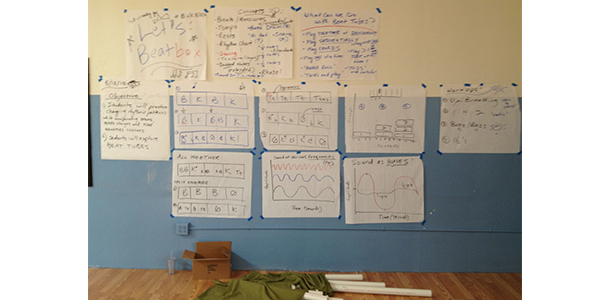Blog

Tube Beat or Not To Be? Discovering Sound through Rhythm and Movement
By Max Bent, Musician and beatboxer

Young Audiences artists and teacher partners have written case studies documenting their work in schools and their exploration of one essential question. Each study provides a snapshot of how the artist or teacher works with students to integrate the arts into the curriculum and provide opportunities for students to imagine, create, and realize their full potential through the arts.
Project or Program Summary
I first experienced beat tubes (capped PVC tubes that produce distinct pitch) while playing in the ensemble of fellow Young Audiences artist Kevin Martin. Inspired by their simplicity and immediate impact on students, I worked with a team of fifth- and sixth-grade teachers to design an arts-integrated beat tube residency. Our team began with the essential question “What is sound?” Through interacting with and playing the beat tubes, students experienced the propagation of sound while applying principles of music and dance during a culminating group performance.

Purpose and Rational
Beat tubes offer a wealth of possibilities for further exploration of arts-integrated teaching. As an instrument, beat tubes are linked in heritage to Tamboo Bamboo in Trinidad as well as numerous folk music traditions surrounding the pounding of grain into flour. This case study is submitted in the hopes of inspiring other educators to experiment with beat tubes.
Analysis and Outcomes
What are your overall conclusions regarding the documentation gathered for this case study?
Students learned that the phenomenon of sound can be understood as patterns of vibration through a medium–usually air. These patterns of vibration are called “sound waves.” “Pitch” and “volume” are aspects of sound waves that can be manipulated by musicians to express ideas and feelings.
What conclusions have you drawn from the responses to the assessment tools you have developed?
Students gained new insights into the phenomenon of sound. Students also improved their ability to work together cooperatively and to communicate in a collaborative setting.
Back to the initial inquiry question, can it be answered?
Yes. After the residency, students were able to identify and discuss specific scientific terms related to sound (i.e. frequency, amplitude, wavelength) and use this knowledge to enrich their compositions.
Playing the beat tubes connected body and mind in the practice of music. Students learned to play rhythmic patterns on steady beats but the challenge was both physical (kinesthetic) and mental.
Summary and Conclusions
What was learned?

By playing the beat tubes, students were able to objectify the often confusing and mysterious nature of sound. Students were able to approach the inquiry question scientifically.
Students learned:
- Sound is a phenomenon that our brains perceive and process in a specific, predictable way.
- The physical characteristics of sound are frequency and amplitude.
- The frequency of a sound wave is defined in musical terms as pitch.
- Different pitches form melodies and harmonies, both of which can be defined mathematically through interval relationships.
What can be done differently in the future?
I introduced the residency with beatboxing (vocal percussion) activities during the course of three days. In the future, one day of beatboxing would suffice. This would allow more time for working with the beat tubes and further discussion and analysis of the scientific principles of sound.
I would have liked to give students more time to compose independently. Also, students can potentially be involved in the construction of the beat tubes in the future.
How will this inform the work moving forward?
This project inspired me to expand the possibilities of working with beat tubes. Specifically I learned that vocalizations and movement are essential to successful instruction. Therefore I will explore the elements of dance as well as other related musical traditions (i.e. drum lines, West African drumming) to improve the project. Overall, I was amazed at the possibilities of working with beat tubes.
Curriculum Connections
Music
Science
Dance
21st Century Skills
Learn more about Max’s assembly, residency, and professional development programs.
Read other case studies written by Young Audiences teaching artists and teacher partners.








